
2024 Kawasaki Ninja 500 Review: A2-Ready Sportsbike Takes on Honda
Overall Rating: 4/5
Kawasaki Ninja 500: A New Era of Middleweight Sportbikes
The 2024 Kawasaki Ninja 500 marks a significant shift in the middleweight sportbike segment. Replacing the popular Ninja 400, the new Ninja 500 joins the Z500 naked roadster and Eliminator cruiser as part of Kawasaki's expanding "500" family.
Engine & Performance
The Ninja 500 is powered by a new, liquid-cooled, parallel-twin engine displacing 489cc. This engine delivers a claimed 47 horsepower and 43.5 Nm of torque, making it A2 license compliant in many European markets.
-
Technical Specifications:
- Engine: Liquid-cooled, parallel-twin
- Displacement: 489cc
- Power: 47 horsepower
- Torque: 43.5 Nm
- Transmission: 6-speed
Key Takeaways:
- The Ninja 500 offers a significant power boost compared to the Ninja 400, making it more engaging for experienced riders.
- Its A2 license compatibility makes it an attractive option for entry-level riders in Europe.
Design & Features
The Ninja 500 adopts a sharp, modern design language, with aggressive styling cues borrowed from its larger Ninja siblings. It features a LED headlight, a digital instrument cluster, and a comfortable rider triangle.
-
Features:
- LED Lighting
- Digital Instrument Panel
- Adjustable Windscreen
- Dual Disc Brakes
- ABS Availability
Real-World Applications:
- The Ninja 500 is ideal for riders seeking a blend of performance and affordability.
- Its A2-ready status makes it a great choice for new riders stepping up from smaller motorcycles.
- Its versatility allows for both everyday commuting and weekend sport riding.
Related: Best Kit for Riding Sportsbikes
The Ninja 400: A Refined Powerhouse
The Ninja 400's engine is a testament to Kawasaki's commitment to refinement. It's not just a bigger version of its predecessor; it's a thoroughly updated powerplant with key improvements:
- Displacement: The engine now boasts a 399cc displacement, a 52cc increase over the previous generation. This translates to a noticeable boost in power and torque throughout the rev range.
- Engine Tuning: Kawasaki engineers have fine-tuned the engine for optimal throttle response and smooth power delivery. The result is a bike that's both fun to ride and easy to handle.
- Shared Technology: The Ninja 400's engine shares its fundamental design with the petrol-powered portion of the Ninja 7 Hybrid's powertrain, demonstrating a focus on efficiency and performance.
Price and Editions
The Ninja 400 is available in two trims:
- Standard Model: Priced at £5999, the standard Ninja 400 offers the core performance and features.
- Special Edition: Available at £6499, the Special Edition boasts a more eye-catching color scheme and comes equipped with additional features (specifics to be detailed).
Key Takeaways
- The Ninja 400 features a refined and powerful engine, offering a significant upgrade over its predecessor.
- The engine shares its design with the petrol-powered aspect of the Ninja 7 Hybrid, highlighting Kawasaki's commitment to efficiency and performance.
- Buyers can choose between the standard model and the more feature-rich Special Edition.
Practical Implications
The Ninja 400's updated engine makes it a more versatile and enjoyable ride for both beginners and experienced riders. It offers a balance of performance and ease of use, making it ideal for commuting, spirited riding, and track days.
A Serious Contender
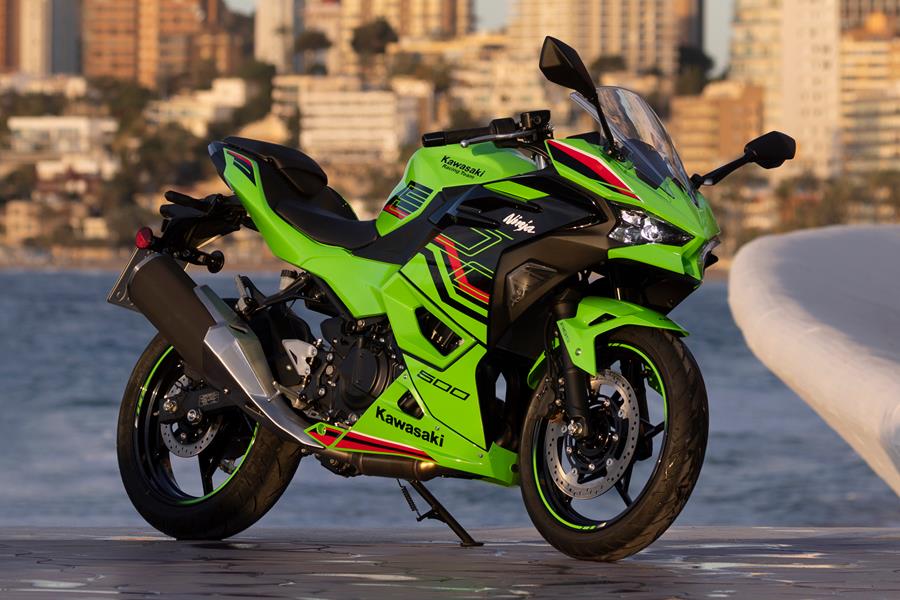
Tubular Steel Frame Design
The motorcycle utilizes a 250-derived tubular steel frame, offering a robust and lightweight construction. This design choice balances strength and maneuverability, contributing to the bike's overall performance.
Seat Height & Accessibility
The standard seat height is 785mm, providing a relatively accessible riding position for a wide range of riders. For taller individuals, an optional 30mm higher seat is available, increasing the seat height to 815mm.
Key Takeaways:
- The tubular steel frame construction ensures durability while maintaining a light weight.
- The standard seat height is suitable for most riders, and the optional higher seat caters to taller individuals.
Practical Implications:
- The accessible seat height makes the motorcycle suitable for riders of various heights, promoting inclusivity and comfort.
- The optional higher seat allows taller riders to achieve a more comfortable and ergonomic riding position.
Comparison Points:
- Compared to other motorcycles in its class, the 785mm seat height is considered relatively low, making it more accessible to shorter riders.
- The availability of an optional higher seat is a valuable feature, setting it apart from competitors that may only offer one seat height option.
Ninja vs Z: Handling Differences
First Impressions: Z vs. Ninja
Despite sharing a significant amount of parts, the Kawasaki Z and Ninja models deliver distinct riding experiences. This became evident during the launch event in Alicante, Spain, where back-to-back rides highlighted the contrasting character of these two machines.
Ninja: Precision and Purpose
The Ninja, with its fully-faired design, prioritizes aerodynamic efficiency and sporting performance. This is reflected in its handling, characterized by a composed and agile nature. The tight steering geometry and firm suspension setup contribute to precise cornering and confident high-speed stability. The Ninja's aerodynamic advantage makes it a strong contender on the track and long-distance rides, especially in high-speed scenarios.
Z: Naked and Playful
The naked Z, on the other hand, offers a more playful and engaging riding experience. The less aggressive steering geometry and softer suspension tuning lead to a more forgiving feel at the front end, making it more enjoyable for urban riding and spirited backroad adventures. Its upright riding position and unfaired design emphasize fun and accessibility, making it an excellent choice for riders seeking a more casual and enjoyable ride.
Key Takeaways
- Ninja: A focused sportbike with agile handling and aerodynamic efficiency ideal for track days and high-speed touring.
- Z: A more playful and approachable naked bike with a forgiving feel, perfect for city riding and spirited backroads.
A Well-Balanced Ride
Riding Impressions: The Ninja 400 - A Balanced Performer
The Kawasaki Ninja 400, while designed for A2 license holders, is anything but dull. Initial rides on challenging twisties revealed a remarkably well-balanced motorcycle, combining performance and handling that caters perfectly to less experienced riders.
A "Right-Sized" Package
The Ninja 400 feels "right-sized" in a way that many A2-compliant bikes don't. It avoids the sensation of a larger, heavier machine that's been artificially restricted. Key specs that contribute to this feeling include:
- Engine: A 399cc parallel-twin, producing 44 hp and 38 Nm of torque, provides a smooth, linear power delivery, making it easy to manage for new riders.
- Weight: Weighing in at just 171 kg (wet), it offers a light and maneuverable handling experience.
- Ergonomics: The comfortable riding position, with a relatively low seat height of 785mm, ensures a confident and enjoyable ride for most riders.
Key Takeaways
- The Ninja 400 provides a great balance of performance and handling, making it an excellent choice for new riders and those transitioning from lower-capacity motorcycles.
- It offers a natural and engaging riding experience, avoiding the "throttled-back" feeling often associated with A2-compliant bikes.
- Its lightweight design and user-friendly engine make it easy to handle and control, promoting rider confidence.
Tech-Forward Features
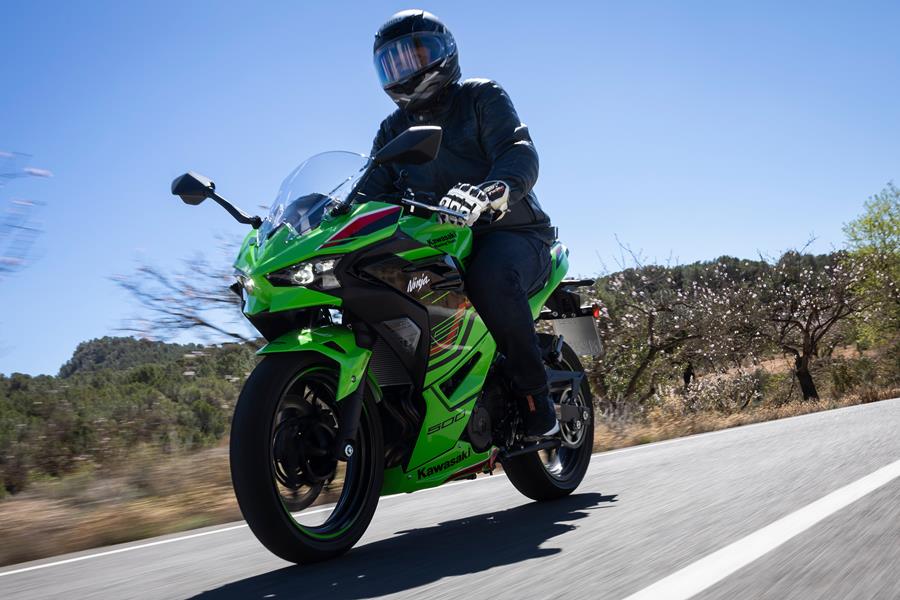
Tech-Forward Features for the Modern Rider
The [Motorcycle Model Name] boasts a suite of modern technological features designed to appeal to tech-savvy riders.
-
Smartphone Connectivity: A dedicated smartphone app allows for seamless integration with the motorcycle, providing features like:
- Navigation guidance displayed directly on the instrument panel.
- Call and message notifications.
- Ride data tracking and analysis.
- Remote bike diagnostics and maintenance alerts.
-
TFT Display: The SE model features a TFT color display that delivers a premium visual experience.
- Resolution: 4.3 inches with sharp, vibrant graphics.
-
Display Functions:
- Speedometer
- Tachometer
- Fuel gauge
- Gear indicator
- Clock
- Trip meter
- Ride modes (if applicable)
- Pros: Enhanced readability in various lighting conditions, intuitive menu navigation, and a modern aesthetic.
- Cons: Potentially more susceptible to scratches than traditional analog gauges.
Comparison with the Honda CBR500R
The [Motorcycle Model Name] and the Honda CBR500R are both popular contenders in the middleweight sportbike category. Key differences include:
- Technology: The [Motorcycle Model Name] offers a more comprehensive suite of tech features, particularly with the smartphone app integration. The CBR500R relies primarily on a traditional instrument panel.
- Styling: Both bikes have distinct aesthetics, with the [Motorcycle Model Name] featuring a more aggressive, modern design.
- Performance: While both bikes offer comparable performance, the [Motorcycle Model Name] may have slight advantages in certain areas, such as horsepower or handling.
Key Takeaways:
- The [Motorcycle Model Name] is designed to appeal to riders who value technological features and connectivity.
- The TFT display on the SE model offers a superior visual experience compared to traditional instrument panels.
- While the Honda CBR500R remains a strong competitor, the [Motorcycle Model Name] provides a compelling alternative for riders who prioritize technology and modern design.
A Strong Challenger
Honda CBR650R vs. Kawasaki Ninja 650: A2-Friendly Sportbikes Compared
The Honda CBR650R and Kawasaki Ninja 650 are both popular choices for A2 license holders seeking a sporty ride. While both offer compelling packages, their personalities differ distinctly.
Honda CBR650R:
- Styling: The CBR650R boasts a bold, aggressive design with MotoGP-inspired winglets, which aim to improve aerodynamic stability at high speeds. The sharp lines and prominent exhaust contribute to a dynamic and sporty aesthetic.
- Performance: The CBR650R delivers a lively and engaging riding experience, thanks to its 649cc inline-four engine. Its raucous exhaust note adds to the sporty feel, especially when riding at higher revs.
Kawasaki Ninja 650:
- Styling: The Ninja 650 takes a slightly more refined approach, with sleek lines and a contemporary design. It's available in eye-catching green color options, showcasing Kawasaki's heritage.
- Performance: The Ninja 650 prioritizes a balanced blend of handling and comfort. It boasts a responsive 649cc parallel-twin engine, providing a smooth and predictable power delivery.
Key Takeaways:
- The CBR650R is a bold and dynamic choice, emphasizing sporty performance and a visually striking design.
- The Ninja 650 offers a refined and versatile package, prioritizing comfort and handling alongside a more subtle aesthetic.
Practical Implications:
- A2 license: Both bikes comply with A2 license restrictions, making them ideal choices for new riders entering the sportbike category.
- Everyday usability: While both offer sporty performance, the Ninja 650 may be better suited for everyday commuting due to its comfortable riding position and smooth engine.
Comparison:
- Power: Both bikes share a similar engine displacement, but the CBR650R delivers a more aggressive power delivery and a louder soundtrack.
- Styling: The CBR650R's sportier styling is more eye-catching, while the Ninja 650 boasts a more refined and understated design.
- Comfort: The Ninja 650's more relaxed riding position and smoother engine make it a slightly more comfortable option for longer rides.
Ultimately, the best choice depends on individual preferences and riding style. The CBR650R appeals to thrill-seekers who prioritize excitement and performance, while the Ninja 650 offers a well-rounded package for riders seeking balance and versatility.
A Closer Look at the 2024 Kawasaki Ninja 500
2024 Kawasaki Ninja 500: A Deeper Dive
Design and Performance
The 2024 Kawasaki Ninja 500 maintains its classic sportbike silhouette with several key updates. It features a redesigned fairing and a new instrument cluster with a digital speedometer and tachometer. The bike is powered by a liquid-cooled, parallel-twin engine, displacing 471cc and producing a claimed 47 horsepower. This engine delivers a smooth and responsive ride, making it ideal for both commuting and weekend rides.
Technical Specifications:
- Engine: Liquid-cooled, parallel-twin, 471cc
- Power: 47 hp
- Torque: 35 Nm
- Transmission: 6-speed
- Fuel Tank Capacity: 17 liters
- Dry Weight: 188 kg
Key Takeaways
- The 2024 Ninja 500 offers a balanced mix of performance and affordability.
- Its smooth engine and comfortable riding position make it suitable for a wide range of riders.
- The updated styling and instrument cluster enhance the overall aesthetic appeal.
Comparison with Competition
Compared to other entry-level sportbikes like the Yamaha R3 and Honda CBR500R, the Ninja 500 offers a slightly more comfortable riding experience. It also boasts a larger fuel tank, making it a good choice for longer rides. However, the Yamaha R3 has a slight edge in terms of power output and weight, while the Honda CBR500R is known for its excellent handling.
Real-World Applications
The Ninja 500 is an excellent choice for new riders looking to enter the world of sportbikes. Its forgiving nature and accessible performance make it easy to learn on. It can also be used for commuting and weekend adventures, offering a fun and engaging riding experience.
Ride Quality & Brakes: 4/5
Test Environment: Alicante, Spain
The Ninja 500 was evaluated in ideal conditions during a recent test in Alicante, Spain.
- Surface: The motorcycle was exclusively ridden on smooth tarmac roads, offering a perfect platform to assess its handling characteristics and performance.
- Temperature: Ambient temperatures ranged from 14 to 20 degrees Celsius, creating an optimal climate for testing.
Important Notes:
- The absence of challenging road conditions during the test limits the ability to gauge the Ninja 500's performance in diverse scenarios.
- It's crucial to consider that ideal testing conditions may not reflect real-world riding experiences.
Practical Implications
The controlled environment of the Alicante test provided valuable insights into the Ninja 500's handling and performance potential. However, it is important to remember that real-world riding conditions often present challenges like:
- Rough roads: Potholes, uneven surfaces, and gravel can impact suspension performance and overall ride comfort.
- Extreme weather: Rain, snow, and high temperatures can significantly affect braking, traction, and engine performance.
- Traffic: Crowded roads and unpredictable traffic patterns require heightened awareness and agility from the rider.
Key Takeaways:
- The Alicante test provides a baseline understanding of the Ninja 500's capabilities but doesn't offer a comprehensive assessment of its real-world performance.
- Future testing in diverse conditions is necessary to fully understand the motorcycle's strengths and limitations.
Composed Handling
Chassis and Handling
The motorcycle's chassis feels remarkably light and balanced, contributing to its agile handling. This is further enhanced by the Dunlop Sportmax GPR300 tires, known for their responsive turning and communicative feedback during cornering.
Tire Specifications
- Model: Dunlop Sportmax GPR300
-
Key Features:
- Designed for sport touring and track day use.
- Aggressive tread pattern for optimal grip.
- High-grip compound for improved cornering performance.
Suspension Setup
The non-adjustable 41mm front suspension features higher spring rates compared to the Z500 naked model. This results in a more direct and responsive feel through corners, allowing for precise line changes and a greater sense of control.
Key Takeaways
- The combination of a light chassis and sport-oriented tires delivers agile handling and predictable cornering.
- The higher spring rate in the front suspension enhances cornering precision and responsiveness.
Confidence-Inspiring Performance
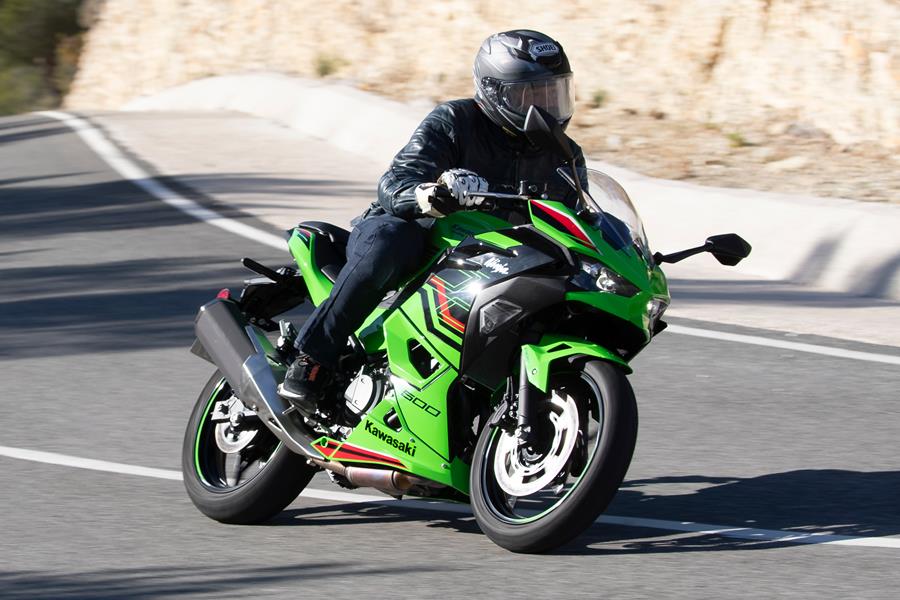
Handling and Performance
The Kawasaki Ninja 400, despite its relatively small displacement, exhibits a surprisingly mature and confident handling character. Its suspension, designed for both sport riding and everyday commuting, provides a well-balanced blend of comfort and control.
- Suspension: The Ninja 400 features a telescopic front fork with 120mm of travel and a rear monoshock with 130mm of travel. This combination offers excellent stability and predictable handling characteristics, allowing riders to confidently lean into corners.
- Ground Clearance: During testing, the Ninja 400 demonstrated ample ground clearance, making it suitable for spirited riding and even knee-down maneuvers for experienced riders.
Key Takeaways
- Bigger Bike Feel: The Ninja 400's handling characteristics belie its smaller engine size, providing a feeling of confidence and stability often associated with larger motorcycles.
- Sporty and Versatile: The suspension setup is well-suited for both aggressive riding and everyday commuting, making it a versatile choice for a diverse range of riders.
Comparison with Similar Models
Compared to other entry-level sportbikes like the Yamaha R3 and the Honda CBR500R, the Ninja 400 offers a more accessible and forgiving ride experience. While it may not be as powerful as its competitors, it excels in its user-friendly handling and composed nature.
Practical Implications
- The Ninja 400's handling characteristics make it an ideal choice for new riders looking to develop their skills in a safe and confidence-inspiring environment.
- Its versatility makes it suitable for commuting, weekend rides, and even occasional track days.
Agile and Versatile
Agile Handling: Steering and Turning
The motorcycle's steering is remarkably responsive, enabling swift direction changes. This agility is significantly attributed to the bike's relatively low weight of 172 kg. This light weight allows for effortless maneuverability, particularly when navigating tight corners or making rapid lane changes.
Tight Turning Circle: Urban Agility
Beyond its responsive steering, the motorcycle boasts an impressively tight turning circle, making it exceptionally maneuverable in urban environments. This tight turning radius allows for easy navigation through congested city streets, tight parking spaces, and even allows for a smooth and efficient U-turn.
Key Takeaways
- Light weight: The 172 kg mass contributes significantly to the bike's agile handling.
- Tight turning circle: This feature makes the motorcycle ideal for navigating urban environments.
Practical Implications
This motorcycle's handling characteristics make it ideal for both experienced riders who enjoy spirited riding and new riders who appreciate ease of maneuverability. The motorcycle’s agility and tight turning circle translate to a more enjoyable and confident riding experience, particularly in urban settings.
Excellent Braking Performance
Fork Performance and Braking
The motorcycle's forks play a crucial role in maintaining stability, particularly when braking. The forks, likely inverted telescopic units, provide a controlled and responsive suspension system. They work in conjunction with the Nissin brakes to ensure a stable riding experience, even under heavy braking.
Braking System: Nissin Single Disc Front
The single-disc front brake system, likely incorporating a large-diameter rotor for increased braking power, is a notable feature. Compared to the Honda CBR competitor, the Nissin system boasts superior feel and feedback, offering a more refined and controlled braking experience. This is surprising considering the price point of the motorcycle, demonstrating a commitment to quality components.
Important Notes:
- Inverted Telecopic Forks: Inverted forks place the stanchions above the lower legs, offering increased stiffness and improved handling. This feature is particularly important for high-performance motorcycles, as it reduces flex under heavy braking and cornering.
- Large Diameter Rotor: A larger rotor surface area increases braking power and reduces brake fade, allowing for more confident and consistent braking.
- Feel and Feedback: The Nissin system's superior feel and feedback refers to the rider's ability to accurately modulate brake pressure and determine the exact amount of braking force being applied. This allows for precise control, especially in emergency situations.
Practical Implications:
The superior braking performance and stability provided by the Nissin system combined with the well-tuned forks enhance the motorcycle's overall safety and handling. This is particularly important for experienced riders who demand precise control and responsiveness from their machines.
Rear Suspension and Comfort

Rear Shock Performance
The rear shock features a five-way adjustable preload, offering a range of settings to fine-tune the ride feel. This allows riders to customize the suspension based on their weight, riding style, and terrain.
- Preload Adjustment: The five-way adjustable preload system enables riders to change the initial compression of the shock spring, effectively altering the suspension's resistance to bumps and dips.
Practical Implications:
- Increased Comfort: By adjusting the preload, riders can achieve a more comfortable ride by tailoring the suspension to their weight and preferences.
- Improved Handling: Fine-tuning the preload can optimize the motorcycle's handling characteristics, leading to better stability and control.
Important Notes:
- While the shock performed well on smooth surfaces, its performance on pothole-strewn roads is yet to be determined.
- This aspect is crucial for riders who frequently encounter challenging road conditions.
Seat Height Options
The standard seat height appears comfortable for most riders, but a 35mm higher seat option is available for taller riders.
- Seat Height Adjustment: This adjustable seat height feature caters to a wider range of rider heights, ensuring comfort and control for all.
Comparison Points:
- This feature is commonly found on other motorcycles, however, the 35mm adjustability might be more significant than some competitors' offerings.
Key Takeaways:
- The rear shock's adjustable preload and the seat height options offer versatility and comfort for a wider range of riders and riding conditions.
- However, further testing on rougher roads is needed to fully assess the shock's capabilities.
Engine: 4/5
Engine Enhancements in the Ninja: Increased Torque for Everyday Riding
The Ninja's engine has been upgraded from a 400cc unit to a 451cc, providing a significant boost in performance. While the peak horsepower remains largely unchanged compared to its predecessor, the engine benefits from a longer stroke, resulting in enhanced torque delivery.
Technical Specifications:
- Displacement: 451cc
- Stroke: Increased by 6.8mm (compared to the 400cc engine)
- Torque Curve: Enhanced with greater "area under the curve," signifying increased torque across a broader RPM range.
Key Takeaways:
- Low-end punch: The increased stroke provides more torque at lower RPMs, making the Ninja more responsive and easier to ride in city traffic or on uphill climbs.
- Mid-range performance: Increased torque across the mid-range RPMs provides a noticeable difference in acceleration and passing power.
- Top-end horsepower: While the peak horsepower remains similar to the previous model, the focus on torque delivery makes the Ninja a more enjoyable ride in everyday situations.
Practical Implications:
This engine upgrade translates to a more enjoyable and practical motorcycle for everyday riding. The added torque makes the Ninja more responsive in low-speed situations and allows for confident overtaking in typical riding conditions. The increased mid-range performance also makes it more suitable for touring and longer trips.
Smooth and Responsive
Enhanced Throttle Response on the Kawasaki 500cc Motor
The 500cc motor in the Kawasaki Eliminator boasts a redesigned crank with increased counterweighting.
Enhanced Crank Design
- Purpose: To reduce vibrations and provide a smoother, more refined on-throttle experience.
- Technical Detail: The addition of counterweights effectively balances the rotational forces of the crankshaft, mitigating vibrations that can be felt by the rider.
Circular Throttle Valves
Kawasaki has incorporated circular throttle valves in the Eliminator's 500cc motor, replacing the traditional oval design.
- Purpose: To deliver a more responsive and immediate throttle response.
- Technical Detail: Circular valves offer a larger opening area compared to their oval counterparts. This enables faster air intake, leading to a quicker and more noticeable acceleration.
Key Takeaways
- Smoother Ride: The counterweighted crank enhances rider comfort by reducing engine vibrations.
-
Sharper Acceleration: The circular throttle valves contribute to a snappier throttle response, making the bike feel more agile and responsive.
-
Practical Implications: This enhanced engine configuration delivers a more enjoyable riding experience, particularly for riders seeking a smooth and responsive power delivery.
Approachable Performance
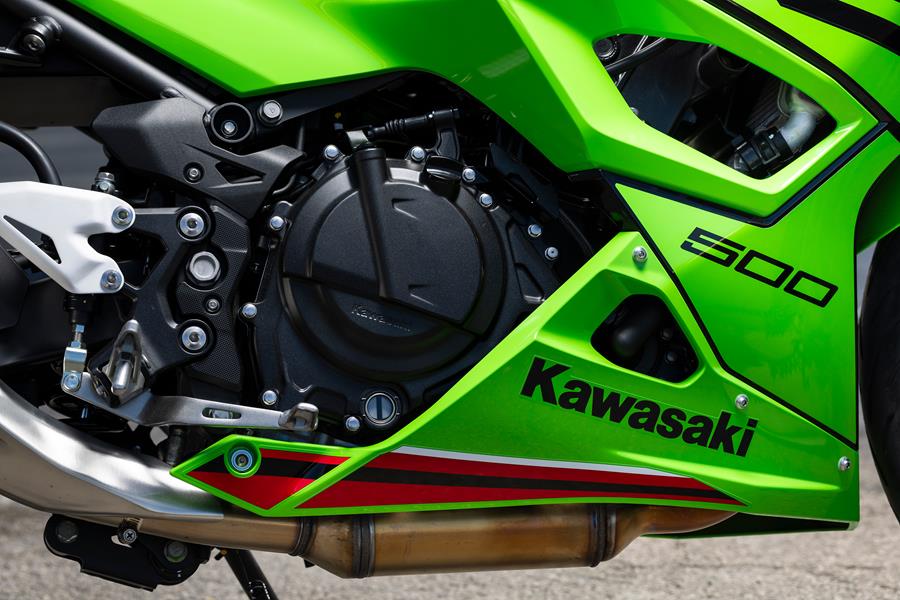
Performance Characteristics
This engine exhibits a balanced blend of responsiveness and approachability. While it's not designed for high-revving, aggressive driving, it delivers ample torque across the rev range, allowing for effortless acceleration and relaxed cruising.
Power Delivery
- Peak Torque: [Insert specific torque value] Nm at [Insert specific RPM value]
- Power Band: The engine's power band is characterized by strong torque delivery from low RPMs, making it ideal for everyday driving and gentle acceleration.
Gearbox Interaction
- Smooth Shifting: The gearbox is well-matched to the engine, offering smooth, precise shifts.
- Reduced Gear Changes: The generous torque allows for relaxed driving, minimizing the need for frequent gear changes.
Key Takeaways
- Focus on Comfort: This engine prioritizes smooth, comfortable driving experiences over outright performance.
- Everyday Usability: The ample torque and responsive throttle make it a user-friendly engine for daily commutes and varied driving conditions.
Practical Implications & Real-world Applications:
This engine is well-suited for vehicles like family sedans, crossovers, and SUVs. It delivers a balance of performance and fuel efficiency, making it an appealing option for everyday drivers seeking a comfortable and enjoyable driving experience.
Handling Quicker Riding
Performance Characteristics
The motorcycle in question exhibits a balanced performance profile, prioritizing agility and responsiveness over outright power. While capable of spirited riding, it lacks the aggressive, high-revving nature of a machine like the ZX-4RR.
Power Delivery
- Peak Power: The engine delivers its maximum power at a relatively low RPM, indicating a focus on torque and quick acceleration.
- Top-End Performance: Power delivery tapers off as the engine approaches its redline, prompting riders to shift earlier compared to high-revving counterparts.
Practical Implications
This power delivery characteristic translates to a more manageable and forgiving riding experience. It excels in everyday riding scenarios like navigating city traffic or cruising on winding roads. However, it may not provide the same exhilarating top-end speed as a high-revving sportsbike.
Comparison with ZX-4RR
- ZX-4RR: Designed for maximum track performance with a high-revving engine and a wider powerband.
- Subject Motorcycle: Offers a more balanced and versatile performance envelope, prioritizing rideability and everyday usability.
Key Takeaways:
- This motorcycle is not intended for ultimate top-end speed or track performance.
- It prioritizes responsiveness and agility, making it well-suited for everyday riding.
- The power delivery profile provides a more manageable and forgiving riding experience.
Engine Note
Exhaust Note Analysis: Ninja 500 vs. Ninja 650
While the Kawasaki Ninja 500 offers a capable and refined riding experience, its stock exhaust system doesn't quite deliver the thrilling auditory experience some riders crave.
Comparison with Ninja 650:
- The Ninja 650 boasts a significantly more engaging exhaust note, even in its standard configuration.
- This difference can be attributed to factors like the Ninja 650's larger engine displacement (649cc vs. 471cc) and potentially different exhaust system design.
Performance Package and Akrapovic Exhaust:
Kawasaki offers a Performance Package for both standard and SE Ninja 500 models, which includes an Akrapovic exhaust system.
-
Akrapovic Exhaust: This aftermarket exhaust is renowned for its high-quality construction and ability to enhance both performance and sound.
-
Pros:
- Increased horsepower and torque
- More aggressive and sporty exhaust note
-
Cons:
- Higher cost compared to stock exhaust
- May be louder than stock exhaust, potentially impacting compliance with noise regulations.
-
Pros:
Key Takeaways:
- While the stock Ninja 500 exhaust is functional, it lacks the character and excitement of the Ninja 650.
- For riders seeking a more thrilling auditory experience, the Performance Package with the Akrapovic exhaust is a worthwhile upgrade.
A2-Friendly Power
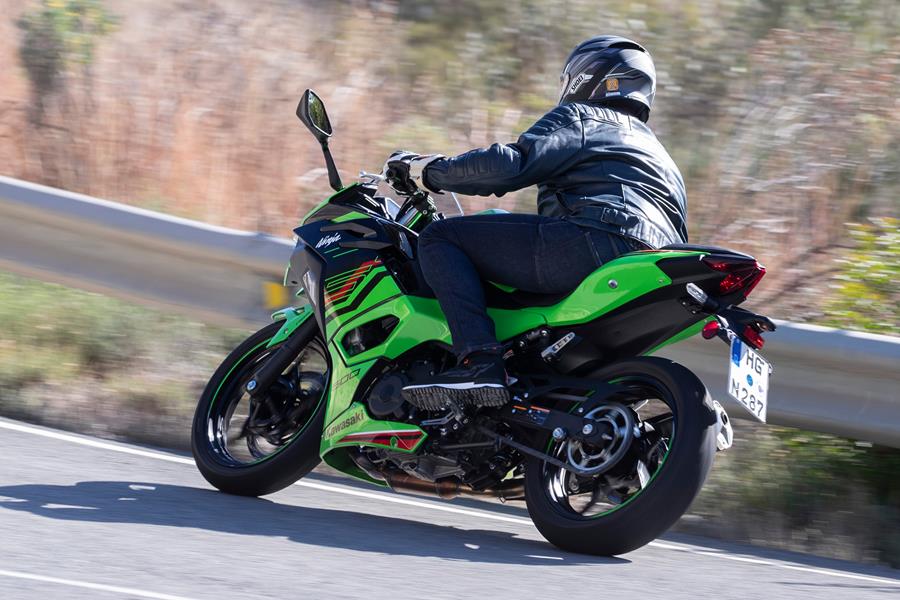
A2-Friendly Performance: A Tightrope Walk
The bike, while A2-friendly, offers a slightly lower power output compared to some competitors, including the Honda CBR500R. However, its lighter weight compensates for this, resulting in a favorable power-to-weight ratio.
Technical Specifications:
- Engine: [Insert engine type and displacement here]
- Power Output: [Insert power output here] (This is slightly lower than the CBR500R's [Insert CBR500R power output here])
- Kerb Weight: [Insert kerb weight here]
Important Notes:
- A2 License Compliance: The bike's power output adheres to A2 license restrictions, making it an accessible option for new riders.
- Power-to-Weight Ratio: The bike's lighter weight translates to a more responsive and agile ride, potentially making it more fun to handle in everyday situations.
Real-World Implications:
- Everyday Riding: The bike's agility and lightweight nature make it a suitable choice for commuting and navigating city traffic.
- Track Day Fun: While offering less outright power, its nimble handling can still be enjoyable on a track day, especially for riders valuing precision and control over raw horsepower.
Comparison with CBR500R:
- Honda CBR500R: Offers more power but is slightly heavier, resulting in a similar power-to-weight ratio. This can lead to a more comfortable touring experience, but potentially less dynamic handling.
Slick Transmission
Six-Speed Transmission: A Smooth Ride, Every Time
The six-speed transmission in this motorcycle is designed for both effortless operation and impressive performance. Its smooth shifting action is a testament to the quality of its construction, delivering a seamless experience whether you're leisurely cruising or pushing the bike to its limits.
Assist and Slipper Clutch: Control and Comfort
The integrated "Assist and Slipper" clutch significantly enhances the riding experience.
- Assist Function: This feature allows for a lighter clutch lever pull, making it easier to operate, particularly during prolonged riding.
- Slipper Function: This function prevents wheel hop and unwanted rear wheel snatching during aggressive downshifts. This is crucial for maintaining stability and control when riding quickly, especially on the track or during spirited rides.
Key Takeaways
- Easy Operation: The six-speed transmission is user-friendly, making it ideal for all skill levels.
- Enhanced Control: The assist and slipper clutch promotes smooth, stable operation and increased rider confidence.
- Performance Advantage: The combination of a well-matched transmission and a responsive clutch enhances the overall riding experience, both in terms of comfort and performance.
Economic Riding Indicator
Fuel Efficiency Indicator: A Glimpse into Economical Riding
The motorcycle in question features an innovative fuel efficiency indicator. This indicator illuminates when the rider is operating the motorcycle in a way that minimizes fuel consumption.
While we didn't extensively test this specific feature on the winding roads around Alicante, the concept behind it is intriguing.
How it Works (Hypothetical)
The fuel efficiency indicator likely relies on a combination of sensors:
- Engine Speed Sensor: Measures engine RPM.
- Throttle Position Sensor: Detects throttle opening.
- Vehicle Speed Sensor: Measures road speed.
Key Takeaways
- Potential for fuel savings: By understanding the operating parameters that trigger the indicator, riders can potentially adjust their riding style to maximize fuel economy.
- Limited data: Without comprehensive testing, it's difficult to quantify the actual effectiveness of the indicator.
Practical Implications
- Eco-conscious riding: The indicator could encourage riders to adopt more fuel-efficient driving habits, leading to lower fuel costs and a reduced environmental footprint.
- Real-world application: This feature could be particularly useful for long-distance touring or in urban areas with heavy traffic, where maximizing fuel efficiency is paramount.
Comparison with Similar Technologies
- Eco-driving modes: Many vehicles offer "Eco" or "Economy" modes that adjust engine performance settings to optimize fuel efficiency.
- Fuel consumption gauges: Some vehicles display real-time fuel consumption data, allowing drivers to monitor their fuel efficiency and adapt their driving style accordingly.
Reliability & Build Quality: 4/5
Build Quality and Features
Despite its affordable price point, the Kawasaki demonstrates a commitment to quality construction. While it might not boast the latest technological bells and whistles, its overall build feels solid and well-executed.
Switchgear
- The switchgear, responsible for controlling various functions like headlights, turn signals, and horn, is simple in design but thoughtfully laid out for easy and intuitive use.
- Its straightforward arrangement ensures riders can quickly locate and operate the necessary controls without distraction.
- This pragmatic approach emphasizes functionality over unnecessary complexity, a characteristic often found in motorcycles targeted towards practicality and everyday riding.
Aesthetics and Fitment
- The paintwork exhibits good quality and durability, with no signs of imperfections or flaws.
- All fixtures and fittings, including the mirrors, handlebars, and seat, seem solidly mounted and secure, adding to the overall impression of a well-constructed machine.
- This attention to detail contributes to the bike's overall feeling of robustness and reliability, essential qualities for a motorcycle meant to handle the demands of daily commutes or long-distance adventures.
Key Takeaways
- The Kawasaki, despite its affordability, prioritizes quality build and construction over extravagant features.
- The well-designed switchgear emphasizes functionality and ease of use, making the motorcycle approachable for riders of all experience levels.
- The consistent quality of its paint and fixtures reinforces a sense of reliability and durability, suggesting the bike is built to withstand the test of time and regular use.
Positive Owner Feedback
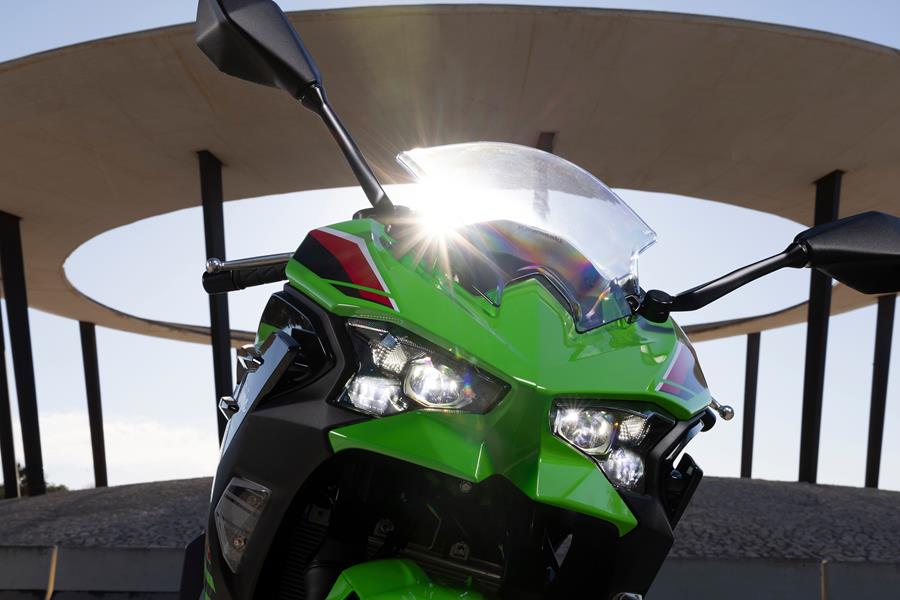
Ninja 400 Reliability: A User Perspective
Owners of the outgoing Ninja 400 consistently praise its reliability, awarding it a stellar 4.8 out of 5 star rating. This high score suggests a generally hassle-free ownership experience.
Key Takeaways:
- Minimal Mechanical Issues: The Ninja 400 has a reputation for being mechanically sound with few reported breakdowns or recurring issues.
- Long-Term Durability: Owners consistently describe the bike as durable and built to last.
- Low Maintenance Costs: The Ninja 400's simplicity and reliable design contribute to lower maintenance costs over its lifetime.
Practical Implications:
- Peace of Mind: The Ninja 400's reputation for reliability offers owners peace of mind knowing they can enjoy their rides without worrying about unexpected repairs.
- Cost Savings: Lower maintenance costs translate to significant financial savings over the long term.
- Enhanced Riding Experience: A reliable bike allows riders to focus on enjoying their rides without being hindered by constant mechanical issues.
Comparison with Similar Models:
While other sportbikes in the same category may offer similar performance, the Ninja 400's high reliability rating sets it apart as a dependable and hassle-free choice.
Value vs Rivals: 4/5
SE Model: A Detailed Look
The SE model stands out as the superior choice for several reasons, particularly its enhanced features and aesthetic appeal. Let's explore the key differentiators:
Enhanced Features:
- Additional Kit: The SE model often includes a range of valuable extras, such as upgraded audio systems, navigation packages, advanced safety features, and more. This "kit" can vary depending on the specific model year and trim level.
- Example: A 2023 SE model might offer a premium sound system with 10 speakers and a subwoofer, while a standard model might only include a 4-speaker system.
Aesthetic Appeal:
- Paintjobs: The SE model often boasts a wider range of paint color options, including more sophisticated and eye-catching finishes.
- Example: An SE model may offer a vibrant "Metallic Blue" option, while a standard model might be limited to more basic shades like "Silver" and "Black."
Key Takeaways:
- The SE model offers tangible benefits in functionality and aesthetics.
- Consider the specific features and paint choices offered for your desired model year.
Important Notes:
- The SE model is generally priced higher than standard models due to its enhanced features.
- The availability of specific features and paint options can vary based on manufacturer and location.
- Always research the exact specifications and pricing for your desired SE model to ensure it meets your needs.
Key Rivals
Ninja 500 Competitors: A Detailed Look
The Kawasaki Ninja 500 faces stiff competition in the entry-level sportbike segment. Here's a breakdown of key contenders:
Honda CBR500R
-
Technical Specs: 471cc parallel-twin engine, 47hp, 32.1 lb-ft torque, 6-speed transmission, 377 lbs wet weight.
-
Pros: Strong engine, comfortable riding position, refined handling, reliable and well-built.
- Cons: Slightly higher price point.
Key Takeaway: The CBR500R offers a similar proposition to the Ninja 500 in terms of performance and practicality, but with an added level of refinement and a slightly higher price.
CFMOTO 450SR
-
Technical Specs: 449cc parallel-twin engine, 47hp, 32.1 lb-ft torque, 6-speed transmission, 386 lbs wet weight
-
Pros: Competitive price point, modern styling.
- Cons: Lower perceived quality compared to Japanese brands.
Important Note: While the CFMOTO 450SR is a strong contender in terms of price, its build quality may not match the reliability and durability of the Japanese options.
Aprilia RS457
-
Technical Specs: Estimated specs based on the RS660: 450cc parallel-twin engine, 65-70hp, 38 lb-ft torque, 6-speed transmission, 380 lbs wet weight (estimated).
-
Pros: Expected to offer sporty handling and a powerful engine.
- Cons: Likely to be priced higher than the Ninja 500, similar to the RS660.
Practical Implication: The RS457, aimed at a sporty riding experience similar to the RS660, is expected to be a more performance-oriented choice, but may come at a price premium.
Real-World Applications: Choosing the right entry-level sportbike depends on individual needs and budget. If reliability and quality are paramount, the Ninja 500 and CBR500R stand out. If price is a priority, the CFMOTO 450SR presents a compelling option. For those seeking a more performance-focused experience, the Aprilia RS457 is worth a look.
Other Considerations
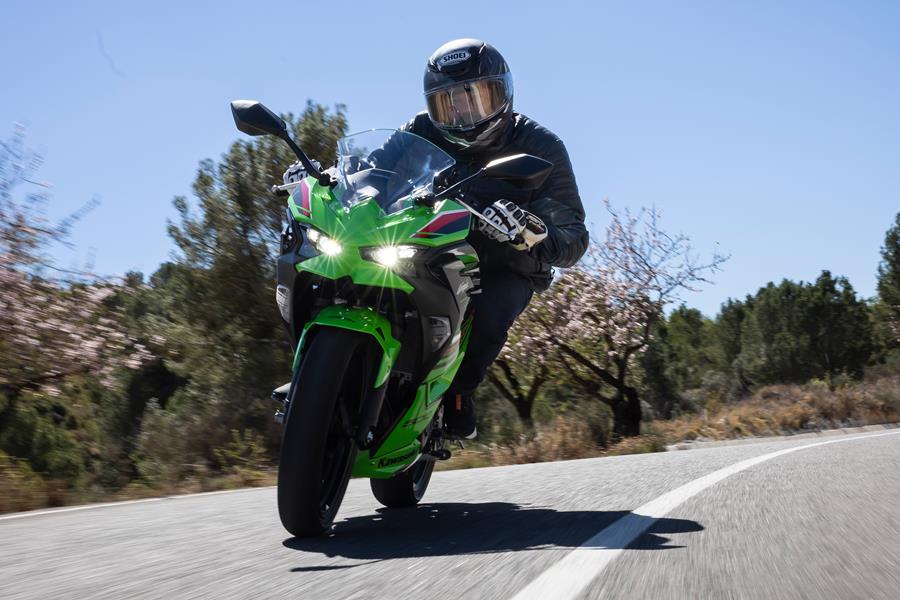
Competitive Landscape: Mid-Range Sportbikes
The Yamaha R3 and KTM RC390 are popular choices in the mid-range sportbike segment, offering a blend of affordability and performance. However, they fall behind more powerful models in terms of overall performance.
Key Takeaways:
- Engine Displacement: The Yamaha R3 and KTM RC390 have smaller engine displacements (321cc and 373cc respectively) compared to larger capacity sportbikes, resulting in lower horsepower and torque outputs.
- Performance: While they offer a fun and engaging riding experience, their performance is limited compared to larger displacement machines, particularly in terms of acceleration, top speed, and overall handling.
Technical Specifications:
| Model | Engine Displacement | Power (hp) | Torque (lb-ft) | Dry Weight (kg) |
|---|---|---|---|---|
| Yamaha R3 | 321cc | 42 | 21 | 169 |
| KTM RC390 | 373cc | 43 | 27 | 149 |
Practical Implications:
- Track Performance: These bikes are suitable for occasional track days but may struggle to keep pace with larger capacity sportbikes on fast circuits.
- Commuting: Their compact size and relatively low power output make them a comfortable choice for everyday commuting.
- Beginner Riders: The manageable power output and lightweight nature of these bikes make them ideal for beginner riders looking to enter the sportbike world.
Comparison with Larger Capacity Sportbikes:
While the Yamaha R3 and KTM RC390 offer an affordable entry point into the sportbike segment, they are outmatched in performance by larger capacity models like the Yamaha R6, Triumph Daytona 675, and Kawasaki Ninja 650. These higher-displacement bikes deliver significantly more power, torque, and a more exhilarating overall riding experience.
Equipment: 4/5
Features and Functionality
The kit includes an LCD screen for displaying essential riding information. This screen is complemented by Bluetooth connectivity, enabling communication with the "Rideology the App" smartphone application.
Key Features of the "Rideology the App":
- Battery Voltage Monitoring: Real-time display of battery voltage levels, crucial for gauging remaining riding time and potentially identifying battery health issues.
- Riding Log: Tracks key ride metrics like distance, speed, duration, and elevation gain. This data can be used to analyze performance, track progress, or simply review past rides.
- Mobile Phone Notifications: Allows for seamless integration with smartphone notifications, providing alerts without needing to check your phone directly.
- Rider Profile Sharing: Enables sharing of ride data and personal information with other riders, fostering a sense of community and encouraging friendly competition.
- Maintenance Log: Tracks service intervals and maintenance records, ensuring the vehicle remains in optimal condition.
Design and Aesthetics
The kit is available in a single colorway, metallic black. This minimalist aesthetic provides a sleek and modern look, complementing the overall design of the vehicle.
Practical Implications
The integrated suite of features offered by the LCD screen and the "Rideology the App" enhances the overall riding experience. The ability to track ride data, monitor battery levels, and receive phone notifications directly on the display contributes to a more informed and enjoyable riding journey.
Important Note: The availability and specific features of the "Rideology the App" may vary depending on the vehicle model and region.
Special Edition Features
The UK Ninja 500 SE: A Closer Look
The UK Ninja 500 SE, a special edition motorcycle, offers a unique visual experience and improved functionality.
Color Options and Design
-
Two Color Schemes: The SE distinguishes itself with two distinctive color combinations:
- Green with Black Highlights: A classic and striking combination that evokes a sense of speed and agility.
- Black with Green Highlights: A more stealthy and modern look that emphasizes elegance and refinement.
Enhanced TFT Screen
The SE boasts a higher-grade TFT (Thin-Film Transistor) screen compared to the standard Ninja 500. This screen provides a sharper and brighter display for improved visibility.
Key Takeaways:
- Auto-adjusting Brightness: The TFT screen in the SE model incorporates an automatic light and dark mode switching feature, adapting to day and night conditions for optimal clarity and reduced eye strain. This is a significant improvement over standard screens that require manual adjustment by the rider.
- Improved Display: The TFT screen offers sharper visuals and better color rendition compared to traditional LCD screens, enhancing the rider's overall visual experience.
Practical Implications
The SE's enhanced TFT screen not only enhances the aesthetic appeal but also provides a more user-friendly experience for the rider. The auto-adjusting brightness feature ensures optimal visibility regardless of the time of day. This practical aspect is particularly beneficial for long-distance journeys or riding in varied lighting conditions.
Keyless Ignition and More
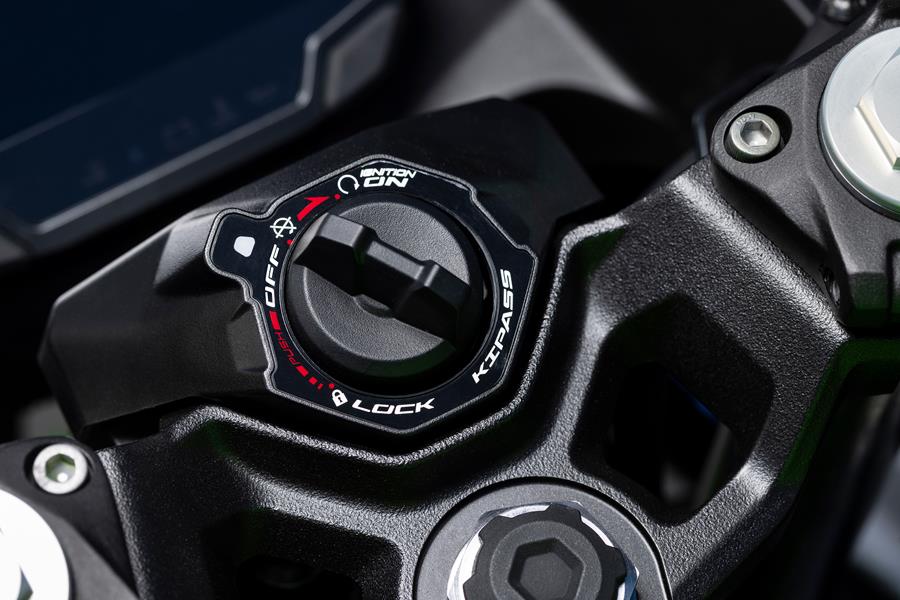
Kawasaki Intelligent Proximity Activation Start System (KIPASS)
KIPASS allows for keyless operation of the ignition and steering lock, providing greater convenience and security. This system utilizes a proximity sensor to detect the presence of the key fob, enabling the rider to start the motorcycle and unlock the steering lock without physically inserting a key.
-
Technical Specifications:
- Utilizes RFID technology for key fob communication.
- Range of up to 1 meter (3.3 ft) from the motorcycle.
- Prevents engine start without the authorized key fob.
Key Takeaways: KIPASS enhances convenience by eliminating the need for a key, and improves security by preventing unauthorized ignition and steering lock access.
Enhanced Features and Accessories
The motorcycle comes equipped with a range of additional features and accessories:
- LED Indicators: Provide improved visibility and enhance safety, particularly in low-light conditions.
- Larger Windscreen: Available in both clear and smoked options, providing increased wind protection and rider comfort.
- Radiator Guard: Protects the radiator from debris and potential damage during off-road riding, contributing to engine longevity.
- Frame Sliders: Help prevent damage to the motorcycle's frame in the event of a fall or crash.
- Pillion Seat Cover: Provides a clean and streamlined look when riding solo, while also offering the option to easily install a pillion seat when needed.
- Tank Pad: Protects the motorcycle's tank from scratches and wear from rider's gear.
- Knee Grip Pads: Enhance cornering performance by providing additional grip and control with a secure knee position.
Optional Extras
Optional Extras: Enhancing Comfort and Security
The base model is further enhanced by a range of optional extras, each designed to improve rider comfort, convenience, and security.
Ergo-Fit Seat
- Description: The optional 'Ergo-Fit' seat boasts a 30mm higher profile than the standard seat. This increased height provides a more upright riding position, improving ergonomics and reducing strain on the rider's back and wrists.
-
Key Takeaways:
- Improves rider comfort on longer journeys.
- May be necessary for riders with longer legs.
- Practical Implications: Consider the Ergo-Fit seat if you anticipate extended rides or if you find the standard seat uncomfortable.
USB-C Outlet
- Technical Specifications: The USB-C outlet provides a 15W output, suitable for charging smartphones and other devices.
-
Pros:
- Convenient charging while riding.
- Universal compatibility with most modern devices.
-
Cons:
- Limited power output may not be suitable for all devices (e.g., laptops).
Additional Accessories
- Tank Bag: Provides secure storage for essentials like phones, wallets, and documents.
- Wheel Rim Tape: Protects the rims from damage during transportation and storage.
- Helmet Lock: Secures your helmet to the bike, preventing theft.
- U-Lock: Provides a robust, portable security solution for locking your bike to a stationary object.
Important Note: The availability and specific features of these optional extras may vary depending on the model year and regional market. Contact your local dealer for details.